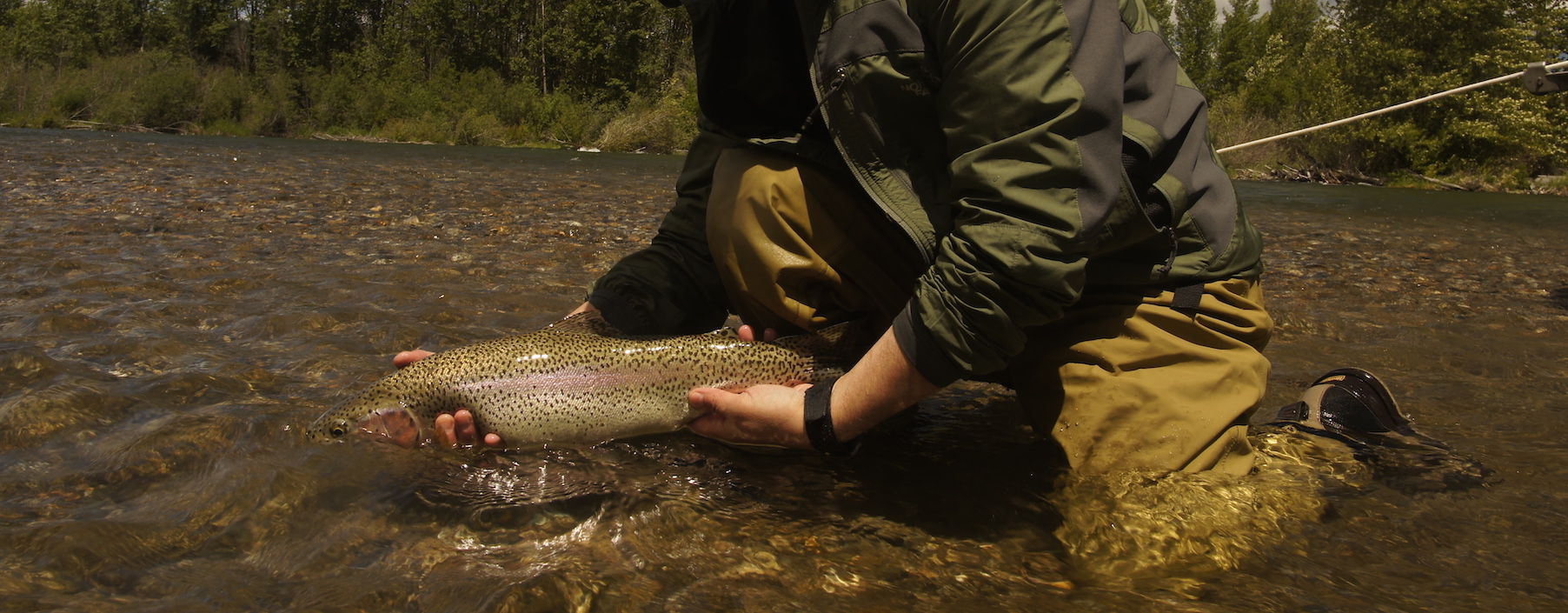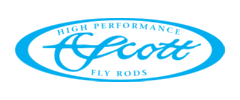Yakima River, WA
The Yakima River, which is approximately 1 ½ to 2 hours from Seattle, is Washington state's only blue ribbon trout stream. There are good numbers of rainbow trout which average 11" to 13" with pods of larger fish also available. There are a few cutthroat in the mix as well, but rainbows predominate. The Yakima is primarily a tailwater, but a few major tributaries give it a freestone stream feel as well. It flows out of the east side of the Cascades from several resevoirs through Cle Elum and Ellensburg before reaching the Rosa Dam, which marks the end of the blue ribbon stretch of this river. The Yakima is a fertile river and has many of the insects that are found throughout the west. Baetis, PMD's and Mahoganies are plentiful, caddis are strong from mother's day into the fall and there are enough Skwala and summer stones to keep things interesting through the summer. Terrestrials generally abound during the heat of the summer and early fall, so hoppers and ants will produce during this time. Fall brings on more baetis mayflies, plus the large October Caddis. In the dead of winter, warmer days produce midge hatches that get the fish moving our of their winter doldrums.
The Yakima is open year round, but each season has it's charms and challenges. Winter is the most difficult period as cold water slows the fish down, but a slight warming trend will get the fish moving to streamers or an occassional midge hatch. This is challenging fishing, but if you are on the river during a brief warming spell, you will have the river, the scenery and the fish to yourself. Spring brings prolific hatches and possibly the best fishing (especially dry fly fishing) of the year, however, if it gets too warm, runoff from local tributaries can raise the river and make it unfishable. Once the river stabilizes, the fishing generally picks up. Summer has consistent flows, but the river runs high for several months as water releases from the resevoirs are started to allow for farmer irrigation. This time of year is a boaters show and wading options are limited. Fall is quite possibly the best season as consistent low flows generally prevail and reliable hatches occur after the summer heat dissipates and before the extreme cold of winter sets in. The fall color in the streamside vegetation and trees coupled with equinox lighting in the canyon is something to experience.
Weather and Flows Links
- Fishing Report
- Water Levels Overview
- Water Levels at Umtanum
- Forecast Flows Overview
- Forecast Flows at Umtanum
- Weather at Cle Elum
- Weather at Ellensburg
Fly Fishing the Yakima River
Within a day-trip of Seattle, the Yakima river blends incredible scenery with blue-ribbon trout fishing. Complex and varied, the 70+ mi. of fishable waters from Keechelus Dam to Roza Dam offer countless opportunities and challenges for a lifetime of fly fishing. Although it’s tempting just to pack up and drive over at any time, it’s important to be aware of the variance in seasonal water volume when fishing the Yak. Managed for irrigation of the Kittitas valley, the flows can vary greatly especially during the summertime. June to August river volumes are consistently between 4,000 – 6,000 C.F.S (cubic feet per second), a powerful flow best left to experts on the oars. Check the flows before you go or give us a call. Wading the river when the flows at Umtanum are above 1,000 C.F.S. is not recommended.
When is the Yakima River Open to Fishing?
Fishing regulations are subject to emergency closures and they change from year to year, so before you go, know what you are fishing for and always check the regs: http://wdfw.wa.gov/fishing/regulations/ . Feel free to give us a ring with questions. It’s better to be safe than sorry!
The Yakima is open year round from Keechelus Dam to Roza Dam. It’s managed under selective gear regulations, which means single, barbless hooks. Either use specialized, barbless hooks to tie your flies or make sure you crimp and file your barbs. You can fish up to 3 flies on the Yakima. All trout must be released.
Upper Yakima River
Characterized by high-gradient, braiding runs filled with large rock, woody debris and crystal-clear water, the upper section of the river is worth getting to know. After all, it’s only short drive over Snoqualmie Pass to get into some great trout fishing! Although the river is open from its source at the base of Keechelus Dam, the Yakima below Easton Dam is generally acknowledged as the starting point for quality water. Shortly below Easton, the river joins with the Cle Elum and gains volume. Generally speaking, the very upper stretches of river see fewer anglers and less pressure, but they can also be more difficult to access and have a shorter overall fishing season due to a higher elevation with colder water temperatures.
The river around the town of Cle Elum offers good foot and boat access and varied water types to reward any skill level. Anglers can spend days exploring the access points along local trails and never exhaust all of the possibilities. Wading should only be attempted during the spring and fall months; summertime flows can quadruple the volume of water and make bank fishing your only option! Rule of thumb: do not attempt wading if the river at Umtanum is above 1,000 C.F.S..
Below the confluence of the Teanaway river, the Yakima enters the Upper Canyon section. Foot access is drastically reduced as the river cuts its way through basalt cliffs, along strands of cottonwood, and around sharp bends and breathtaking river features. Scenery is second only the Lower Canyon section, wildlife abounds, and the sharp bends can offer some respite from gusts on a windy day. Shortly before Thorpe, the river opens up again and enters the Farmlands section above Ellensburg.
Running any length of the upper Yakima requires experience on the oars, and summertime flows are not to be underestimated in their power. For example, the section directly below the East Cle Elum or State boat launch is a dangerous S-curve complete with a strainer that should be avoided. We offer guided trips on these sections, and if you are interested in gaining whitewater experience, we work with a local outfitter who specializes in teaching whitewater safety. Please don’t hesitate to give us a call.
Farmlands and Lower Canyon Sections
A particularly wonderful stretch of river to fish with dry flies when the trout are eating off the surface, the Farmlands is characterized by big, sweeping bends and broad runs. Despite its source in 3 upper reservoirs, the Yakima has a distinct freestone feel in this section. Grassy banks with plenty of holding water beckon the well-presented dry fly on a long drag-free drift. If you enjoy casting the double-handed rod for trout, you will find plenty of large bars to swing soft-hackles and streamers in both the Farmlands and the Lower Canyon. Because this section of the river meanders along the flatlands between Thorpe and Ellensburg, windy days are generally the rule, so bring your fast-action rod and make sure your hat is on tight!
Shortly below Ringer road near Ellensburg, the Yakima enters the Lower Canyon section. Home to the greatest population of fish, the Lower Canyon is an absolute must for any trout angler. Vistas of rugged basalt walls greet you along every curve of the river. Waterfowl, eagles, falcons, herons and osprey call the canyon home, as well as beaver and otter. It is not unusual to spot herds of Bighorn sheep along the canyon as they descend to the bank. Every conceivable piece of holding water exists in the Lower Canyon: from huge sweeping riffles to rip-rap pools to cliffside runs, pocket-water, braids, islands, and everything in between. Couple the scenery and wildlife with the possibility of big trout all-year round, and you have a formula for a great day on the water!
There is excellent access for the wading angler along the entire length of the Lower Canyon, as well as campsite managed by the BLM. As noted previously, wading should be limited to the low flows of spring and fall around 1,000 C.F.S. at Umtanum. The quality of the Lower Canyon section is not a secret, and rare is the day of complete solitude. Expect to fish among other anglers whether you are floating or on foot.
Below Roza Dam the quality trout fishing water ends, however, the lower Yakima by Prosser offers excellent smallmouth bass fishing.
What Can I Catch on the Yakima?
The Yakima river boasts some of the best rainbow trout fishing in the state. Average rainbow's are in the 12 - 15 in. range, with good numbers of fish from 16 - 20 in. Certain times of year produce some of the larger fish. March through June, and then again in October, the larger fish can be found eating off the surface.
Westslope cutthroat are some of the best reasons to go fish the Yakima. These fish are highly colorful and love to chase flies on the surface. You will find the largest concentration of cutties in the upper river above the town of Thorpe. Instead of holding in the faster, aerated stretches of the river which rainbows prefer, cutthroat are often found in the slower sections of river, holding tight to the bank, or dipping in and out of faster seams for a meal.
You’ll also run into whitefish, squawfish and pike minnow. Few anadromous fish make their return, but there is a remnant wild Yakima steelhead population which must be immediately released if caught.
Tips on Fly Fishing the Yakima
Yakima trout are wild, healthy, and keep you coming back to land the big one that got off last trip (or get another one!). For those who put in time and effort, there is no better local trout fishery than the Yakima. The number of tough days you’ll encounter are balanced out over the course of the season by short windows when the river fishes extremely well. It’s not unusual to get a few fish to hand in a day, and great days certainly happen on a regular basis. Take these tips to heart if you are thinking of fishing the Yakima.
- We have fewer fish than other areas of the country, especially the prolific rivers of Montana, Idaho and Colorado, so you must cover water to find fish. If you are coming from a different area of the country, work to change your expectations. Skip the marginal stuff. Focus on the structure that screams, “fish are here.”
- Because the fish are spaced farther apart, it is worth floating if you can swing it. We offer guided trips along every section of the Yakima, and a day with a guide can drastically reduce your learning curve on these waters.
- Fish do feed on the dominant insect hatching, but they are also opportunistic and will eat streamers with reckless abandon. In fact, the Yakima is one of the best rivers around to swing streamers.
Spring
Subject to variable weather that can render the river unfishable, springtime can be challenging on the Yakima. However, it’s also the time to find Skwala stoneflies, March Brown mayflies, Blue Wing Olive mayflies and American Grammon caddis on the surface, and the well-timed trip can offer the multiple surface eats even when the air temperature is chilly.
The majority of the spring months are primarily a time to fish nymphs under an indicator with a stout, fast-action rod. The extra power will serve you well while throwing a double-nymph rig. A standard-issue large stonefly trailed by an attractor mayfly such as a Pheasant Tail, Prince Nymph or Hare’s Ear is a good place to start. Keep the dry fly rod strung up, however, as a warming trend can cause insects to hatch and fish to move to them.
Insects to Imitate from March to May: Skwala stonefly dries and nymphs, March Brown mayfly dries and nymphs, transitioning to March Browns dries and spring Blue Wing Olives, then Salmonflies and Caddis in May
Summer
Summer has consistent flows, but the river runs high for several months as water releases from the reservoirs begin for farmer irrigation. This time of year is a boater’s show and wading options are limited. Insect-wise, early summer is a smorgasbord of PMDs, caddis, small stones, golden stones and a mix of other mayflies, and it’s important to use a variety of techniques both above and below the surface for consistent action. Terrestrials and summer stones come into play during mid-summer, and the prospect of active fish hammering a hopper pattern during a hot day becomes the norm. The standard summertime rig during high flows is a large dry, such as a Chubby Chernobyl or grasshopper imitation, trailed by a flashy beadhead like a Flashback Pheasant Tail, Lightning Bug or Anato May. Fish the hopper-dropper rig close to the bank and expect some great takes. Streamers can also fish very well all summer long.
Insects to Imitate from June to August: Large variety of insects, with PMDs and Caddis being primary early then large stones and terrestrials. Fish big dry flies to imitate terrestrials and stones!
Fall
Fall is quite possibly the best season on the Yakima. Consistently low flows and reliable hatches occur after the summer heat dissipates and before the extreme cold of winter sets in. You’ll find consistent surface action on Blue Wing Olive mayflies and October Caddis, as well as a variety of lesser mayflies and terrestrials. Fishing during the period of time known as the “flip-flop” as the flows are reduced from their summertime highs can mark extremely good fishing, so keep your eye on the gauges. This is the time of year you’ll find pods of fish sipping Blue Wing Olive mayflies as well as large trout feeding on the surface with seemingly no regard for their own safety! Light tippets and good presentations are essential for success during this period of time.
Insect to Imitate from September to November: Summer stones, caddis, and a variety of mayflies, with transition to October Caddis and fall Blue Wing Olive mayflies as winter approaches
Winter
Winter is the most difficult period as cold water slows the fish down, but a slight warming trend will get the fish moving to streamers or an occasional midge hatch. This is challenging fishing, but if you are on the river during a brief warming spell, you will have the river, the scenery and the fish to yourself.
Insects to Imitate December to February: Focus is on midges and small nymphs, and as spring approaches trying larger stones and attractors.
Guiding and Expert Instruction
A guide can take years off the learning curve. The best way to experience the Yakima is during a full-day float of the lower river, or during a full-day walk-and-wade trip to one of the forks. We also offer steelhead schools and spey-casting instruction.Recommended Equipment
Trout rods in 3 – 6 weight
|
Floating line for dry flies and nymphs
|
Recommended Flies
| Suggested Dry Fly Patterns | Suggested Nymph Patterns | Suggested Streamer Patterns |
|---|---|---|
Caddis Dries 12 – 18
|
Stoneflies in 8 – 12
|
|











